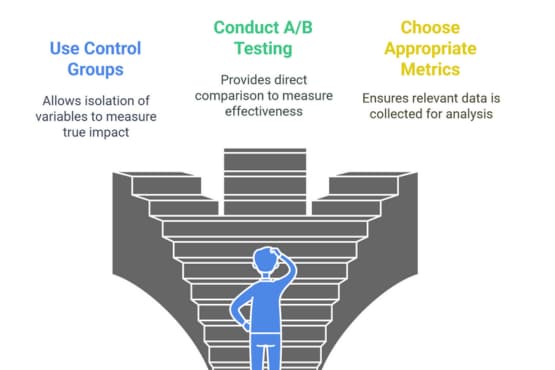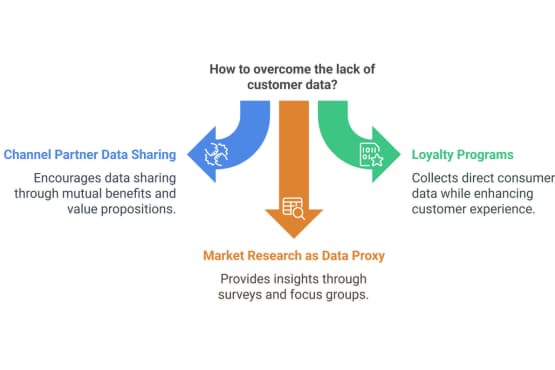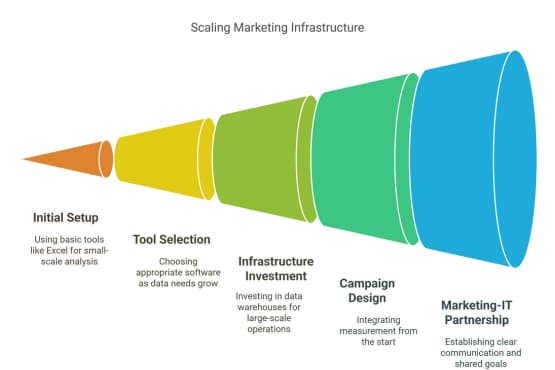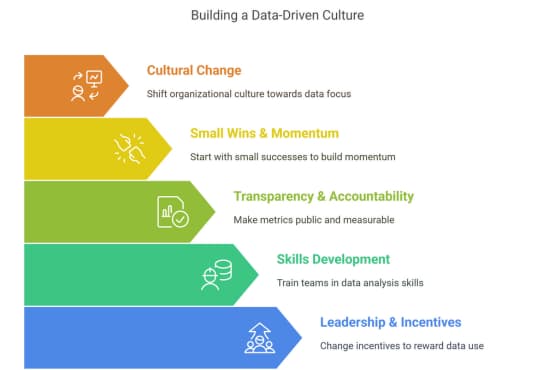Despite knowing the importance of data-driven marketing, most still struggle to implement it effectively. Data-driven marketing challenges persist as brands attempt to make smarter decisions, allocate budgets more efficiently, and prove marketing value through an understanding of customer behavior. Yet research shows that less than 30% of trade marketers feel confident in their data approaches, creating a widening gap between marketing leaders and laggards.
The challenges of creating a data-driven marketing approach cross organizations of all sizes. Whether you work with retail partners, manage channel relationships, or handle trade promotions, five specific obstacles consistently block progress. By understanding and overcoming these barriers, you can transform your trade marketing performance and gain competitive advantage.
This article provides practical, tested solutions for each challenge, with real-world examples from companies that successfully made the transition. Let’s explore the roadmap to data-driven trade marketing excellence by leveraging digital marketing platforms.
Obstacle 1: Getting Started
The Challenge
The first obstacle often paralyzes trade marketers before they even begin. You might recognize these common statements:
- “We don’t know where to start.”
- “We need better metrics, but which ones?”
- “Plus We have too much data, but none of it seems useful.”
- “We need perfect data before we can make decisions.”
This paralysis stems from the overwhelming volume of available data coupled with uncertainty about which information will drive real value.

The Solution
The secret to getting started isn’t having perfect data or comprehensive systems—it’s identifying the 20% of data that drives 80% of value, then creating momentum with an “easy win” project.
Royal Bank of Canada (RBC) exemplifies this approach. When Cathy Burrows led their data-driven initiative, she started by looking internally at existing operations. “You have to look at what you do today and think, ‘How can I do this better, cheaper, faster, and smarter?'” Burrows explained.
RBC focused on individual retirement account (IRA) contributions. The marketing team built a model analyzing over 1 million customers and scoring them to find 250,000 high-potential contributors.
Rather than attempting to overhaul all marketing processes at once, they created targeted lists of the top 25 prospects for each salesperson.
The results proved transformative: 8 out of 10 customers called accepted the offer to set up IRAs. However, driving adoption took time—only 25% of sales reps used the lists initially. By year three, participation reached 75%, and the success enabled Burrows to build a business case for a larger $4 million initiative.
Practical Application for Trade Marketers:
- Begin with a single, focused trade marketing problem that affects profit
- Use existing data, even if imperfect
- Apply the 80/20 rule to focus on high-impact metrics
- Document early wins to build internal support
- Scale successful approaches to larger initiatives
Walgreens provides another instructive example. Their marketing manager analyzed store locations against customer addresses, discovering that customers rarely traveled more than two miles to visit stores.
By eliminating newspaper advertising in zip codes without stores in a two-mile radius, Walgreens saved $5 million with only a $200,000 investment in data analysis.
Obstacle 2: Causality – Conduct Small Experiments
The Challenge
Trade marketers frequently struggle to isolate what’s working when multiple campaigns run simultaneously. This creates three common problems:
- Overlapping promotions make determining cause and effect impossible
- Time lags between marketing activities and customer responses blur connections
- Financial teams demand direct ROI even for awareness-building activities
Without clear causality, it becomes difficult to defend marketing investments or optimize future campaigns.

Solution
The key to solving causality challenges lies in systematic testing and choosing appropriate metrics for different marketing activities. Control groups and A/B testing provide powerful tools to isolate variables and measure true impact.
Harrah’s Entertainment, a leading casino company, routinely designs experiments to quantify marketing impact. In one example, they tested two offers for frequent slot machine players in Jackson, Mississippi. The control group received their standard package: a $125 hotel room, two steak dinners, and $30 in casino chips. The test group received only $60 in chips, without the room or meals.
Surprisingly, the simpler offer generated higher gaming activity. By expanding these controlled tests to other locations, Harrah’s cut marketing costs by 50% while improving results.
This approach works across channels and campaign types. After Walgreens’ initial success with newspaper advertising, they conducted experiments with different insert types in various zip codes.
Using specific locations as control groups and measuring sales changes through their stores, they optimized newspaper marketing with a systematic, data-driven approach.
For Trade Marketers:
- Design geographic control groups for in-store promotions
- Test different trade allowances with similar retail partners
- Compare channel performance with matched variables
- Use the appropriate metrics for each marketing type:
- Awareness campaigns: brand recall, consideration measures
- Demand generation: sales lift, redemption rates, ROI
- Match the timing of measurement to expected consumer response patterns
Microsoft employs similar geospatial testing for anti-piracy marketing, focusing efforts on specific geographic clusters rather than treating all markets equally.
The principle applies widely: different locations and channels respond differently, and marketing should adapt accordingly.
Obstacle 3: Lack of Data
The Challenge
B2B companies selling through indirect channels face a particular data challenge—they don’t know their end customers or how to effectively analyze data. This creates significant obstacles in implementing effective marketing strategies:
- Channel partners control direct customer relationships
- Privacy regulations limit data collection options
- Limited visibility into retail partner performance
- Difficulty attributing sales to specific marketing efforts
Without customer data, trade marketers struggle to segment audiences, personalize communications, or measure marketing effectiveness.

Solution
Three strategic approaches can help overcome this obstacle:
channel partner data sharing, loyalty programs, and using surveys as data proxies.
1. Channel Partner Data Sharing
Cisco Systems, a $39 billion network infrastructure company, sells 95% of its products through value-added resellers (VARs). Unlike most B2B companies who accept “no way” responses when requesting customer data, Cisco contractually requires partners to share sales information.
For companies without Cisco’s leverage, the key is creating value propositions that motivate sharing. Microsoft demonstrated this with original equipment manufacturers (OEMs), providing co-marketing materials that partners wanted, which created willingness to share data showing marketing effectiveness.
The critical question becomes: “What’s in it for my channel partner?” Shared analysis can provide insights that improve the channel relationship and create mutual benefit.
As one trade marketing expert notes, “You don’t necessarily need customer names and addresses—you need purchasing patterns and the ability to act on those insights through your channel.”
2. Loyalty Programs for Data Collection
Suntory, a major Japanese beer manufacturer competing with Asahi and Kirin, created an innovative web-based frequent drinker program. Customers entered codes from bottle caps to earn points redeemable for merchandise.
The program attracted 300,000 monthly visitors—their highest-value customers—providing Suntory direct access to consumer data despite selling indirectly through distributors and retailers.
Similarly, Coca-Cola’s My Coke Rewards (mycokerewards.com) gathered direct consumer data while generating site revenue through advertising.
For trade marketers, loyalty programs provide valuable first-party data while offering consumers genuine value in return, enhancing customer experience.
3. Market Research as Data Proxy
When direct data isn’t available, focus groups and surveys can provide insights for segmentation and targeted marketing. While not as robust as transaction data analysis, this approach offers a starting point for B2B firms facing significant data access challenges.
Professional research firms typically charge $20,000+ for comprehensive focus groups, but companies can start with simpler approaches—online surveys or small customer panels can provide directional insights at lower costs.
All data collection must adhere to ethical standards and privacy regulations. Create clear policies about data usage, communicate them transparently, and ensure data security. The winning approach adds value for customers while respecting their privacy.
Obstacle 4: Resources and Tools
The Challenge
Many trade marketers cite resource constraints as major barriers:
- Limited time and budget for data initiatives
- Lack of appropriate analytical tools
- Communication gaps between marketing and IT teams
- Skills deficits within the marketing team
These constraints can make data-driven marketing seem unattainable without significant investment.

Solution
The solution lies in smart infrastructure investment scaled to your needs, designing campaigns with measurement in mind, and building effective marketing-IT partnerships.
For most marketers, sophisticated tools aren’t necessary to start. Microsoft Excel combined with a laptop provides powerful analysis capabilities for initial projects. The key is designing all campaigns with measurement built in from the beginning.
Mike Feldner at Walgreens started with simple Excel spreadsheets containing advertising circulation distributions by zip code. “It wasn’t hard to get the advertising data into the software and create maps with store and customer locations—we did it all on a PC,” he explained.
The infrastructure requirements scale with data volume and complexity:
| Data Scale | Appropriate Tools | Approximate Cost |
|---|---|---|
| Small (thousands of customers) | Excel, basic analysis | $0-5,000 |
| Medium (tens of thousands) | Specialized marketing analytics software | $5,000-50,000 |
| Large (millions of customers) | Data warehouse, enterprise solutions | $100,000+ |
The critical insight: size requirements depend on both customer numbers and analytical complexity. If your goal is analyzing several thousand customers and designing targeted marketing for these segments, standard business software suffices. For analyzing millions of customers across multiple dimensions, you’ll need industrial-strength infrastructure.
As Richard Winter, an expert in high-performance data warehouse design, explains: “The difference in these requirements is the difference between building a ranch house or the Empire State Building.”
Kelly Cook from Continental Airlines highlighted their practical approach: “We did not have the budget or resources to integrate all of our data, so we focused on the two databases of the 45 silos that, if combined, gave us the greatest return.”
Beyond technology, building an effective marketing-IT partnership requires clear communication:
- Define business requirements before technology solutions
- Speak business language, not technical jargon
- Start with business problems, not technology requests, to create effective marketing campaigns.
- Establish shared goals and metrics
As one marketing leader explained, “The relationship between marketing and IT should be like going to your doctor. You explain symptoms and needs, and they prescribe appropriate solutions.”
Obstacle 5: People and Change
The Challenge
The final and often most difficult obstacle involves people and organizational culture:
- Resistance to measurement and accountability
- Incentives focused on activity rather than results
- Lack of measurement culture
- Skills gaps in data analysis
- Belief that creativity and measurement cannot coexist
These cultural barriers prevent even well-designed data initiatives from succeeding.

Solution
Creating a data-driven culture requires leadership, appropriate incentives, skills development, and a balance between creativity and measurement.
Continental Airlines demonstrates the power of cultural change in adopting data-driven marketing strategies. When Gordon Bethune became CEO in 1994, Continental ranked last on every airline metric. He changed the incentive structure, offering employees $100 monthly bonuses if planes ran on time. The results were immediate—Continental became the number one on-time airline.
Kelly Cook, who worked on Continental’s data-driven marketing, explained their approach: “At Continental, the essential first step was talking to our customers. Focus groups provided invaluable feedback on what needed to change and priorities.”
Their marketing team designed a campaign sending apology letters within 12 hours to high-value customers who experienced service failures. Focus groups showed dramatically different responses from those receiving letters versus control groups. Customers who received letters had an 8% revenue improvement, demonstrating the effectiveness of targeted marketing strategies.
For trade marketers, several principles create cultural change:
- Make metrics transparent and public within the organization
- Design incentives that reward data-driven decision making
- Train teams in basic data analysis skills to overcome the challenges of data-driven marketing.
- Start with small wins to build momentum
- Demonstrate that measurement improves results
Corporate cultures typically fall into three categories: rational, bureaucratic, or political. Understanding your organization’s type helps navigate change. In political organizations, identifying centers of power and building alliances proves essential.
Finding executive sponsors who value results and data-driven approaches creates critical support. In Continental’s case, senior leadership championed the data initiatives, but cultural change also required front-line adoption.
As Mike Gorman, senior director of customer management, noted: “Creating the database was hard work. But once we had the capability, we quickly created tools for customers and the enterprise that generated enormous value.”
Harrah’s Entertainment took a dramatic approach to enforcing data culture change. When casino general managers resisted sharing customer data across properties, the company fired several top-performing GMs who wouldn’t comply with the new data-sharing policy. The organization immediately understood the importance of the new approach.
Implementation Roadmap
Implementing data-driven trade marketing follows a five-stage framework:
- Design – Create clear objectives, align stakeholders, and define metrics
- Diagnosis – Assess current state, identify gaps and opportunities
- Opportunities – Select quick wins with high impact/low effort
- Tools – Develop appropriate measurement systems and models
- Process – Establish recurring reviews and continuous improvement
Begin with a 30-day assessment to diagnose problems and identify quick wins. Focus on demonstrating value through early successes before investing heavily in infrastructure. Balance immediate results with long-term capability building.
Conclusion
Overcoming the five obstacles to data-driven trade marketing requires persistence and a strategic approach. By focusing on the right data, conducting small experiments, finding creative ways to access customer information, building appropriate tools, and creating a measurement culture, trade marketers can transform their effectiveness.
Start your journey with a single focused initiative. Identify an area where better data might improve performance, apply these principles, and document results. Use early successes to build momentum toward larger transformations.
The competitive advantage of crossing the data-driven marketing divide grows more significant each year as companies learn to analyze data effectively.
Those who master these challenges will outperform competitors, optimize spending, and demonstrate clear marketing value. The question isn’t whether you can afford to become data-driven—it’s whether you can afford not to use data to enhance your marketing strategies.




